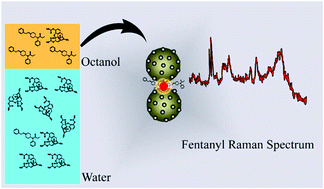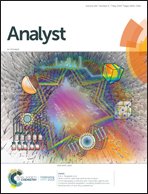Microfluidic analysis of fentanyl-laced heroin samples by surface-enhanced Raman spectroscopy in a hydrophobic medium†
Abstract
Opioid overdose deaths resulting from heroin contaminated with the potent opioid agonist fentanyl, are currently a serious public health issue. A rapid and reliable method for identifying fentanyl-laced heroin could lead to reduced opioid overdose. Herein, we describe a strategy for detecting fentanyl at low concentrations in the presence of heroin, based on the significant hydrophobicity of fentanyl compared to heroin hydrochloride, by preferentially extracting trace concentrations of fentanyl using ultrasound-assisted emulsification microextraction using octanol as the extracting phase. Surface-enhanced Raman spectroscopy (SERS), is enabled by exposing the analyte to silver nanoparticle-coated SiO2 nanoparticles, designed to be stable in mixtures of octanol and ethanol. The sample is then loaded into an SU8/glass microfluidic device that is compatible with non-aqueous solutions. The SERS-active nanoparticles are aggregated by dielectrophoresis using microelectrodes embedded in the microfluidic channels, and the nanoparticle aggregates are interrogated using Raman spectroscopy. Using this method, we were able to reliably detect fentanyl from samples with as low as 1 : 10 000 (mol/mol) fentanyl-to-heroin ratio, improving the limits of detection of fentanyl-laced heroin samples by two orders of magnitude over current techniques. The described system could also be useful in chemical detection where rapid and robust preconcentration of trace hydrophobic analytes, and rapid SERS detection in non-aqueous solvents is indicated.



 Please wait while we load your content...
Please wait while we load your content...